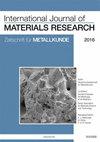绿色合成种子层对化学浴法制备ZnO纳米棒阵列的影响
IF 0.7
4区 材料科学
Q4 METALLURGY & METALLURGICAL ENGINEERING
引用次数: 0
摘要
采用CBD法制备了ZnO纳米棒。在生长之前,用胸腺草提取物在玻璃衬底上播种生物合成的ZnO纳米颗粒。XRD证实,对于前驱体浓度较高的样品,(100)峰明显变短,大部分纳米棒在(002)平面生长,表明晶体沿c轴生长。然而,在0.02和0.05 Mol前体浓度的样品中,纳米棒主要沿着(100)、(002)和(101)平面排列。在六边形纤锌矿结构中存在ZnO纳米棒,有利于沿c轴取向。随着种子层前驱体浓度从0.02 Mol增加到0.1 Mol, ZnO纳米粒子的分散更加密集,最大吸收峰从395 nm红移到420 nm,生物合成ZnO的能带能从3.59 eV降低到3.38 eV。本文章由计算机程序翻译,如有差异,请以英文原文为准。
The impact of green synthesized seed layer on ZnO nanorod arrays grown by chemical bath deposition
ZnO nanorods were synthesized via CBD method on a seed layer coated substrate. Prior to growth, a glass substrate was seeded with the biosynthesized ZnO nanoparticles using Thymus Kotschyanus extract. XRD confirmed that for the sample within higher precursor concentration, the (100) peak is noticeably shorter, and the majority of the nanorods are grown in the (002) plane, indicating crystal growth are along the c-axis. However, the nanorods are mostly aligned along the (100), (002), and (101) planes for samples at 0.02 and 0.05 Mol precursor concentrations. The presence of ZnO nanorods within hexagonal-wurtzite structure, is favored orientation along the c-axis. As the precursor concentrations of the seed layer increased from 0.02 to 0.1 Mol, the dispersion of ZnO nanoparticles became denser, the maximum absorption peaks red-shifted, from 395 to 420 nm, and the bandgap energy of the biosynthesized ZnO decreased from 3.59 to 3.38 eV, with increasing precursor concentrations.
求助全文
通过发布文献求助,成功后即可免费获取论文全文。
去求助
来源期刊
CiteScore
1.30
自引率
12.50%
发文量
119
审稿时长
6.4 months
期刊介绍:
The International Journal of Materials Research (IJMR) publishes original high quality experimental and theoretical papers and reviews on basic and applied research in the field of materials science and engineering, with focus on synthesis, processing, constitution, and properties of all classes of materials. Particular emphasis is placed on microstructural design, phase relations, computational thermodynamics, and kinetics at the nano to macro scale. Contributions may also focus on progress in advanced characterization techniques. All articles are subject to thorough, independent peer review.

 求助内容:
求助内容: 应助结果提醒方式:
应助结果提醒方式:


